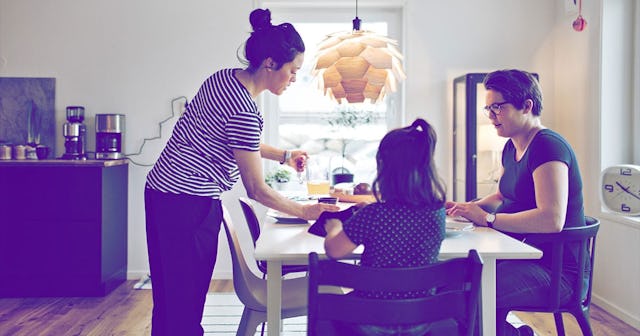I'm Using The '2 Questions' Approach To Have Social Justice Conversations With My Tween

After my 11-year-old son and I watched the news coverage of George Floyd’s murder (no, 11 is not too young), I asked him two questions. I hadn’t planned these questions out ahead of time. They just seemed like a natural way to discuss what we saw. I have now decided that these two questions are essential for conversations about social justice.
Question #1: What do you think about what you just saw?
I was a little taken aback by how angry my son was. I expected him to care, but this age group can be egocentric at times, disconnected from events outside their little microcosm. But my son was visibly angry. With clenched fists and a red face, he cursed and spoke of vengeance.
I let him say his piece without judging his feelings or chastising his word choice. Honestly, I was proud of his outrage. We should all be outraged when we see such a blatant abuse of power, whether or not it affects us personally. Like Benjamin Franklin said, “Justice will not be served until those who are unaffected are as outraged as those who are.”
I don’t think you can move forward with this kind of conversation until you give voice to your honest feelings. Young people need to know that their feelings are not right or wrong…they just are. You can’t help what you feel. But you can control what you decide to do with those feelings, which leads to question #2.
Question #2: What could have been done differently?
I love this question because it is open-ended and invites any possibility. It doesn’t put pressure on a young person to single-handedly solve an overwhelming problem. Rather, it acknowledges that everyone has a role to play in dismantling systemic injustice.
My son said that Chauvin shouldn’t have been allowed to be a police officer in the first place.
“That’s interesting,” I said. “Talk more about that.”
“Well…” He then launched into an elaborate plan to redesign police training programs. He puzzled through different tests and challenges trainers could present that might identify racist behaviors before someone can earn their badge.
The second question moves young people from conversation to activism. Now we can do something! We can research the police training programs in our community. We can build relationships with the police officers in our town and let them know that #BlackLivesMatter is important to us. We can also tell them how much we appreciate all of the police officers (like the one in my own family) who are decent and ethical and dedicated to the communities they swore to serve and protect, and encourage them to speak out against the injustice they see within their own system.
Frederick Douglass said, “It’s easier to build strong children than repair broken men.” So for folks of any color who are eager to do something, invite the young people in your life to study social justice with you. Use the two questions as a springboard for discussion as you read The Hate U Give by Angie Thomas, or watch 12 Years a Slave, or listen to Baratunde Thurston’s TED Talk, “How to Deconstruct Racism, One Headline at a Time.”
My tween and I have some important work ahead of us. It’s not enough that I teach him about our white privilege. We also have to use it. And keep using it. Conversation by conversation, let’s give our young people the permission to feel angry, the tools to investigate, and the power to act.
RELATED: 80+ Relationship Questions That Will Deepen Your Love And Bond
For more resources, check out this list of books about race for kids, from babies to middle grades — and put into practice these five habits to help raise anti-racist kids.
This article was originally published on